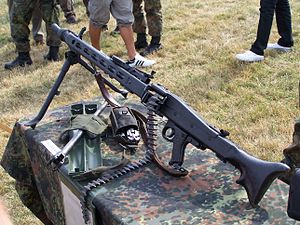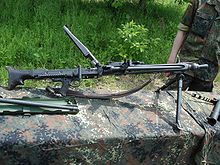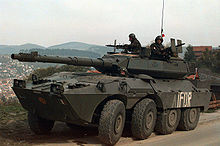- Rheinmetall MG3
-
"Karar" redirects here. For the Iranian unmanned aerial combat drone, see Karrar (UCAV).For the Chinese-made car, see MG 3.
MG3 
MG3Type General-purpose machine gun Place of origin  West Germany
West GermanyService history In service 1960–present Used by See Users Production history Designed 1959 Manufacturer Rheinmetall
License-built by: Beretta, MKEK, Ellinika Amyntika Systimata, Defense Industries Organization, Military Industry Corporation, Pakistan Ordnance Factories, General Dynamics Santa Bárbara SistemasProduced 1960–present Variants See Variants Specifications Weight 10.5 kg (23.15 lb)
27.5 kg (61 lb) (mounted on tripod)Length 1,225 mm (48.2 in)
1,097 mm (43.2 in) (without stock)Barrel length 565 mm (22.2 in) Cartridge 7.62x51mm NATO Action Recoil-operated, roller locked Rate of fire 1000-1300 rounds per minute[1] Muzzle velocity 820 m/s (2,690 ft/s) Effective range 200–1,200 m sight adjustments Maximum range 800 m (bipod)
1,000 m (tripod mounted)
3,000 m (gun carriage)Feed system 50-Round non-disintegrating DM1 belt (can be combined in a drum); 100-Round disintegrating DM6/M13 belt Sights Open Tangent Sights The MG3 is a German general-purpose machine gun chambered for the 7.62x51mm NATO cartridge. The weapon's design is derived from the World War II era MG 42 universal machine gun that fired the 7.92x57mm Mauser round.[2]
The MG3 was standardized in the late 1950s and adopted into service with the newly formed Bundeswehr, where it continues to serve to this day as a squad support weapon and vehicle-mounted machine gun. The weapon and its derivatives have also been acquired by the armed forces of over 30 countries. Production rights to the machine gun were purchased by Italy (MG 42/59), Spain, Pakistan (MG 1A3), Greece, Iran, Sudan and Turkey[3].
Contents
History
 Soldiers of the West German Bundeswehr on exercise in 1960. Pictured is the predecessor to the MG3—the MG 1A3 variant. The soldier on the right is carrying a G3 battle rifle. In the rear stands a HS 30 APC.
Soldiers of the West German Bundeswehr on exercise in 1960. Pictured is the predecessor to the MG3—the MG 1A3 variant. The soldier on the right is carrying a G3 battle rifle. In the rear stands a HS 30 APC.
Production of the first postwar variant of the MG 42 chambered in a standard NATO caliber (designated the MG 1) was launched in 1958 at the Rheinmetall arms factory as requested by the Bundeswehr. Shortly thereafter, the machine gun was modified, receiving a chrome-lined barrel and sights properly calibrated for the new round; this model would be named the MG 1A1 (known also as the MG 42/58).
A further development of the MG 1A1 was the MG 1A2 (MG 42/59), which had a heavier bolt (950 g, compared to 550 g), a new friction ring buffer and was adapted to use both the standard German continuous DM1 ammunition belt and the American M13 disintegrating belt. Further improvements to the weapon's muzzle device, bipod and bolt resulted in the MG 1A3.
Simultaneously, wartime 7.9mm MG 42 machine guns that remained in service were converted to chamber the standard 7.62x51 mm NATO round and designated MG 2.
In 1968, the MG3 was introduced and entered production. Compared to the MG1A3, the MG3 features an improved feeding mechanism with a belt retaining pawl to hold the belt up to the gun when the top cover plate is lifted, an added anti-aircraft sight and a new ammunition box. MG3s were produced for Germany and for export customers by Rheinmetall until 1979. Some additional production of the MG3 in Germany was carried out by Heckler & Koch.[4] The MG3 and its variants all share a high level of parts interchangeability with the original MG 42.
Design details
Operating mechanism
 A partially disassembled MG3 of the German Army.
A partially disassembled MG3 of the German Army.
The MG3 is an automatic, air-cooled, belt-fed short recoil-operated firearm. It features a roller locked bolt mechanism that consists of the bolt head, a pair of rollers, the striker sleeve, bolt body and return spring. The bolt is locked securely by a wedge-shaped striker sleeve, which forces two cylindrical rollers contained in the bolt head outward, and into corresponding recesses in the extension of the breech of the barrel. On firing, both the barrel and barrel extension recoil to the rear. The resulting impact (much like a Newton's cradle) moves the carrier to the rear withdrawing the wedge and both rollers as they are cammed inward and out of their sockets by fixed cams, unlocking the bolt head. The bolt carrier and bolt then continue to the rear together guided by fixed guides while the barrel and barrel extension return to battery. Upon return of the bolt forward, the impact of the rollers against the camming surfaces on the breech carry the rollers from their seats, and, together with the surfaces on the striker sleeve, force the rollers outward, locking the bolt head into the barrel extension and ensuring a complete lock. The bolt also houses a spring-loaded casing extractor and ejector. Ejection is carried out when the ejector strikes the buffer head, sending a push forward through the ejector bar, which hits the ejector pin. This pin pushes the top of the base of the cartridge, which is still held by the extractor at the base, causing the empty casing to rotate and eject downward through the ejection chute.
Features
The machine gun has an automatic-only trigger mechanism and a cross-bolt safety in the form of a button that is operated by the shooting hand (in its "safe" position the bolt release is disabled). The weapon fires from an open bolt. The cyclic rate can be altered by installing different bolts and recoil springs.
The MG3 feeds from the left side through a feed block using metal, 50-round continuous-link DM1 ammunition belts (which can be combined by cartridge) or disintegrating-link M13 or DM6 belts. In the light machine gun role, the MG3 is deployed with a 100-round belt fitted inside a synthetic ammunition drum developed by Heckler & Koch that is latched on to the left side of the receiver. The rear wall of the drum is transparent and serves as a visual indicator for the amount of ammunition available. The feed system operates through a feed arm that is housed in the feed cover. Two feed pawls are linked to the front end of the arm by an intermediate link and move in opposite directions, moving the belt in two stages as the bolt moves back and forward during firing.
Barrel
The MG3 has a quick-change, chrome-lined barrel with 4 right-hand grooves and a rifling twist rate of 1 in 305 mm (1:12 in). Alternatively MG3 barrels can also have polygonal rifling. The barrel is integrated with the barrel breech. The barrel should be changed frequently during sustained firing. The gun is cocked and the barrel catch on the right of the barrel shroud is swung forward. The breech end of the hot barrel swings out and can be removed by elevating or twisting the gun. A fresh barrel is then inserted through the barrel catch and the muzzle bearing. When the catch is rotated back the barrel is locked and the machine gun can resume firing. Both the receiver housing and ventilated barrel casing are made from pressed sheet steel. A muzzle device is mounted at the end of the barrel and it acts as a flash suppressor, muzzle brake and recoil booster.
The machine gun is equipped with a synthetic polymer stock, a folding bipod and open-type iron sights (sliding rear U-notch on a ramp with range settings from 200 to 1,200 m). A flip-up anti-aircraft sight is also provided.
In a stationary, heavy machine gun role the MG3 is mounted on a buffered tripod called a Feldlafette and outfitted with a periscope sight that can be used to engage indirect targets.
Variants
- MG 1: Rheinmetall variant of the MG 42, most notably rechambered to fire 7.62x51 mm NATO.
- MG 1A1 (MG 42/58): As MG 1, but with sights properly calibrated for the new round. Sights refitted to existing MG 1s.
- MG 1A2 (MG 42/59): MG 1A1 variant; product improved with longer ejection port, heavy bolt and friction ring buffer.
- MG 1A3: MG 1A2 variant; product improvement of all major components.
- MG 1A4: MG 1 variant; for fixed mount armor use.
- MG 1A5: MG 1A3 variant; MG1A3s converted to MG1A4 standard.
- MG 2: Designation for all wartime MG 42s rechambered to 7.62x51 mm NATO.
- MG 3: MG 1A3 variant; product improved with AA rear sight.
- MG 3E: MG 3 variant; reduced weight model (roughly 1.3 kg lighter), entered into late 1970s NATO small arms trials.
- MG 3A1: MG 3 variant; for fixed mount armor use.
Deployment
The MG3 is still used as the standard secondary weapon of most modern German armoured fighting vehicle designs (e.g. Leopard 2, PzH 2000, Marder), as a primary weapon on light/non-armored vehicles (e.g. LKW 2to, MAN gl-trucks, ATF Dingo) and as an infantry weapon on light bipods as well as different tripods. However, the German Armed Forces will phase out the MG 3 in 2012, they introduced the HK121 in 2011.[citation needed]
Users
Italy employs the MG 42/59 version primarily on vehicles and rotary-wing aircraft. Seen here mounted on the B1 Centauro wheeled armoured vehicle. Spanish Marine with the MG3. Spanish guns are manufactured by General Dynamics Santa Bárbara Sistemas.
Spanish Marine with the MG3. Spanish guns are manufactured by General Dynamics Santa Bárbara Sistemas.
 Argentina: The MG3 was adopted in the 1960's and has been used as the primary heavy assault gun since then.
Argentina: The MG3 was adopted in the 1960's and has been used as the primary heavy assault gun since then. Australia: The MG3 was used between 1976 and 2007 as an anti-aircraft weapon on the Australian Army's Leopard AS1 MBT.[5]
Australia: The MG3 was used between 1976 and 2007 as an anti-aircraft weapon on the Australian Army's Leopard AS1 MBT.[5] Austria: Uses the MG 74 which is a MG 42/59 variant licensed from Beretta and manufactured by Steyr Mannlicher. The MG 74's cyclic rate of fire is 850 rounds per minute.[6]
Austria: Uses the MG 74 which is a MG 42/59 variant licensed from Beretta and manufactured by Steyr Mannlicher. The MG 74's cyclic rate of fire is 850 rounds per minute.[6] Bangladesh: Used by the Bangladesh Rifles border guards.[7]
Bangladesh: Used by the Bangladesh Rifles border guards.[7] Brazil: Uses the MG3 and the MG3 A1 with the Leopard 1A5 BR[8]
Brazil: Uses the MG3 and the MG3 A1 with the Leopard 1A5 BR[8] Canada: Only used on 20 Leopard 2A6M CAN tanks acquired from Germany.[9] Leopard 2s acquired from other sources will continue to use the FN MAG.
Canada: Only used on 20 Leopard 2A6M CAN tanks acquired from Germany.[9] Leopard 2s acquired from other sources will continue to use the FN MAG. Cape Verde[10]
Cape Verde[10] Chile[11]
Chile[11] Denmark: MG 42/59 designated M/62 in Danish service.[12]
Denmark: MG 42/59 designated M/62 in Danish service.[12] Estonia[13]
Estonia[13] Finland: As the 7.62 KK MG 3. Used with the Leopard 2 tanks and NH90 helicopters.[14]
Finland: As the 7.62 KK MG 3. Used with the Leopard 2 tanks and NH90 helicopters.[14] Germany: Used by the Bundeswehr.[10] A replacement is planned from 2011 onwards.[15]
Germany: Used by the Bundeswehr.[10] A replacement is planned from 2011 onwards.[15] Greece: License production by Hellenic Defense Systems or EAS (formerly Hellenic Arms Industry; Elliniki Biomihania Oplon - EBO).[11][16]
Greece: License production by Hellenic Defense Systems or EAS (formerly Hellenic Arms Industry; Elliniki Biomihania Oplon - EBO).[11][16] Iran: License production by Defense Industries Organization as the MGA3.[11][17]
Iran: License production by Defense Industries Organization as the MGA3.[11][17] Italy: License production of the MG 42/59 by Beretta with parts made by Whitehead Motofides and Luigi Franchi; while largely replaced in squad support weapon role by the Belgian FN Minimi, it still sees widespread mounted use on ground-based vehicles and helicopters.[11][18] Prior to the procurement of the Minimi, the Stabilimento Militare Armi Leggere (SMAL) at Terni has developed a kit to adapt the Italian Army's existing MG 42/59 machine guns to accommodate 5.56x45mm NATO ammunition. The kit comprises a new barrel, bolt head, feed opening and cover, recoil-enhancing element and a lighter bolt. The weight of the modified 5.56 mm MG 42/59 machine gun remains unchanged from the original version.
Italy: License production of the MG 42/59 by Beretta with parts made by Whitehead Motofides and Luigi Franchi; while largely replaced in squad support weapon role by the Belgian FN Minimi, it still sees widespread mounted use on ground-based vehicles and helicopters.[11][18] Prior to the procurement of the Minimi, the Stabilimento Militare Armi Leggere (SMAL) at Terni has developed a kit to adapt the Italian Army's existing MG 42/59 machine guns to accommodate 5.56x45mm NATO ammunition. The kit comprises a new barrel, bolt head, feed opening and cover, recoil-enhancing element and a lighter bolt. The weight of the modified 5.56 mm MG 42/59 machine gun remains unchanged from the original version. Lithuania: Lithuanian Armed Forces.[19]
Lithuania: Lithuanian Armed Forces.[19] Mexico: License produced by SEDENA in Mexico.[20]
Mexico: License produced by SEDENA in Mexico.[20] Myanmar[10]
Myanmar[10] Norway[10]
Norway[10] Pakistan: License production by Pakistan Ordnance Factories in Wah Cantt.[11][21]
Pakistan: License production by Pakistan Ordnance Factories in Wah Cantt.[11][21] Portugal[11]
Portugal[11] Sao Tome and Principe[10]
Sao Tome and Principe[10] Saudi Arabia[10]
Saudi Arabia[10] Spain: Made under license.[11]
Spain: Made under license.[11] Sudan: Made by Military Industry Corporation as the Karar.[22]
Sudan: Made by Military Industry Corporation as the Karar.[22] Togo[10]
Togo[10] Turkey: Made by MKEK in Kırıkkale under license since 1974[23] for the Turkish Armed Forces and Turkish Gendarmerie.[24]
Turkey: Made by MKEK in Kırıkkale under license since 1974[23] for the Turkish Armed Forces and Turkish Gendarmerie.[24]
See also
- General-purpose machine gun
- Heckler & Koch HK121
- MG51 machine gun.
- SIG 710-3, Swiss derivative of MG 42.
Notes
- ^ Hellenic Defense Systems. Eas.gr. Retrieved on 2010-10-18.
- ^ Woźniak, Ryszard: Encyklopedia najnowszej broni palnej—tom 3 M-P, page 106. Bellona, 2001.
- ^ 7.62 mm MG3 MACHINE GUN
- ^ Machine Gun 42
- ^ http://anzacsteel.hobbyvista.com/Armoured%20Vehicles/leopardph_1.htm
- ^ Österreichs Bundesheer - Waffen und Gerät - Maschinengewehr MG 74. Bmlv.gv.at. Retrieved on 2010-10-18.
- ^ [1]. www.bdmilitary.com. Retrieved on 2011-01-10.
- ^ http://www.exercito.gov.br/NE/2010/05/10664/10664.pdf
- ^ Canadian Forces Image Gallery. Combatcamera.forces.gc.ca (2009-10-22). Retrieved on 2010-10-18.
- ^ a b c d e f g Jones, Richard D.; Ness, Leland S., eds (January 27, 2009). Jane's Infantry Weapons 2009/2010 (35th ed.). Coulsdon: Jane's Information Group. ISBN 9780710628695.
- ^ a b c d e f g G3 Defence Magazine August 2010. En.calameo.com (2010-08-04). Retrieved on 2010-10-18.
- ^ [2][dead link]
- ^ Eesti Kaitsevägi - Tehnika - Kuulipilduja MG-3
- ^ 7.62 KK MG 3. Retrieved on April 2, 2008.
- ^ http://geopowers.com/Machte/Deutschland/Rustung/Rustung_2008/Bundeswehrplan_2009.pdf
- ^ 7.62 mm MG3.
- ^ AIG. Diomil.ir. Retrieved on 2010-10-18.
- ^ Esercito Italiano: Il Portale delle Armi dei Materiali e dei Mezzi. Esercito.difesa.it. Retrieved on 2010-10-18.
- ^ (Lithuanian) Lietuvos kariuomenė :: Ginkluotė ir karinė technika » Kulkosvaidžiai » Kulkosvaidis MG-3. Kariuomene.kam.lt (2009-04-17). Retrieved on 2010-10-18.
- ^ http://www.armyrecognition.com/mexico_mexican_army_land_ground_forces_uk/mexico_mexican_army_land_ground_forces_military_equipment_armoured_vehicle_pictures_information_desc.html
- ^ [3][dead link]
- ^ KARAR 7.62x51mm. Retrieved on April 2, 2008.
- ^ MKEK
- ^ [4][dead link]
References
- Ezell, Edward C. (1988). Small Arms Today 2nd Edition. Harrisburg, PA: Stackpole Books.
- (Polish) Woźniak, Ryszard (2001). Encyklopedia najnowszej broni palnej—tom 3 M-P. Warsaw, Poland: Bellona. ISBN 83-11-09311-3.
External links
- Bimbel.de—MG3 disassembled
- Bimbel.de—MG3 on mount
- MG 3 video
- Machine Gun MG3 (MG1A3)
- 7.62 mm MG3 MACHINE GUN
Weapons and military equipment designed or licence-manufactured in IranFirearms PistolsArmour and other
land based vehiclesArtillery HM-40 · HM 41MRLS Recoilless rifles Mortars 37mm Marsh Mortaranti-aircraft guns Anti-tank missiles RPG-7 · Saegheh (rocket) · Type 69 RPG · RPG-29 · RAAD · Saeghe · Toophan · Toophan 2 · Towsan · 9K115-2 Metis-MGeneral Purpose Machine Guns (GPMG) 2B-P-10 · AA-52 · AEK-999 · FN MAG · Heckler & Koch HK21 · Heckler & Koch HK121 · M60 · Mekanika Uirapuru · MG 34 · MG 42 · MG 51 · Pecheneg · PK · MG3 · SIG MG 50 · SIG MG 710-3 · S&T Daewoo K12 · Sumitomo NTK-62 · Type 67 · Type 80 · Type 88 · Uk vz. 59 · UKM-2000 · Vektor SS-77 · Zastava M84Categories:- 7.62 mm machine guns
- Infantry weapons of the Cold War
- General-purpose machine guns
- Machine guns of Germany
- Medium machine guns
- Modern weapons of Germany
- Rheinmetall
Wikimedia Foundation. 2010.






